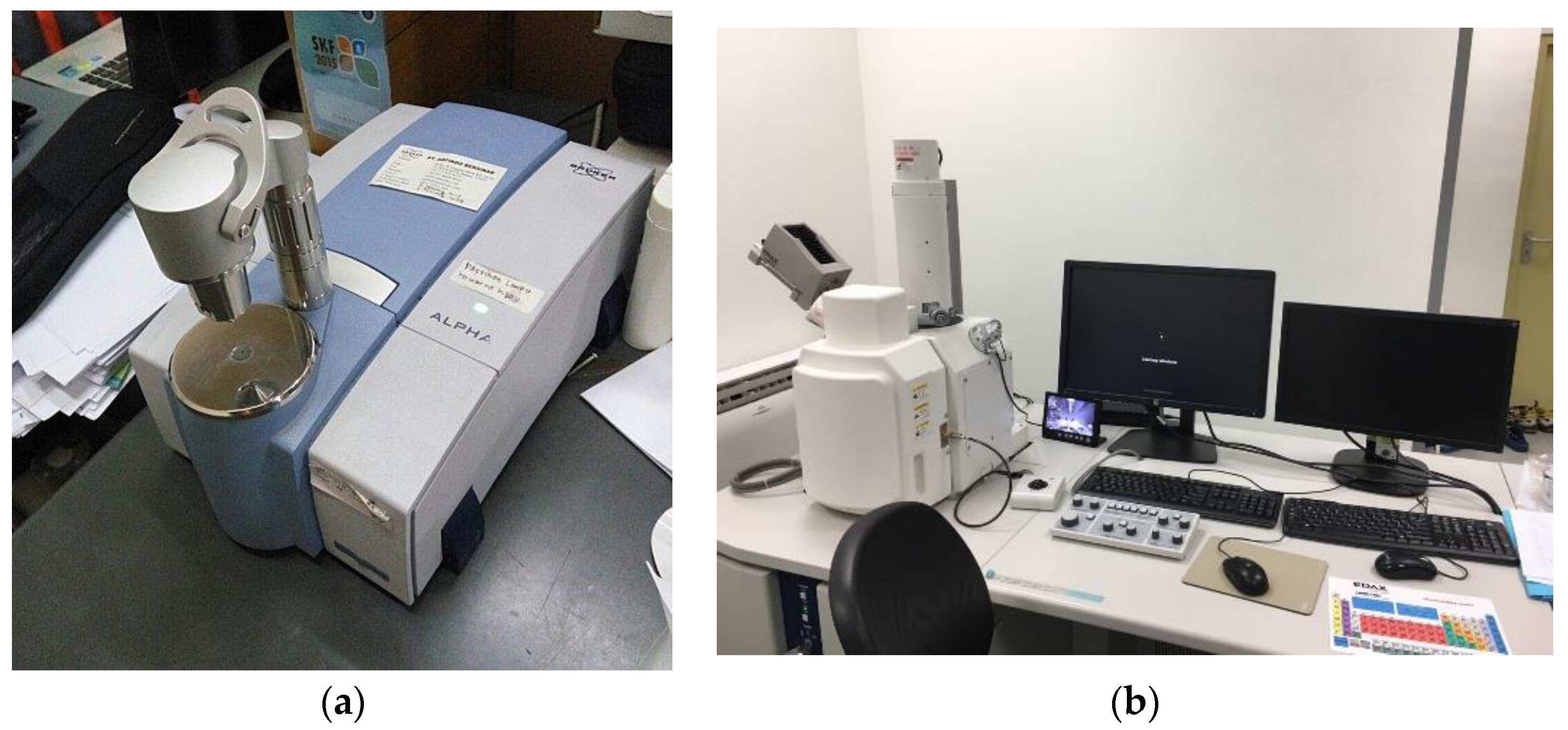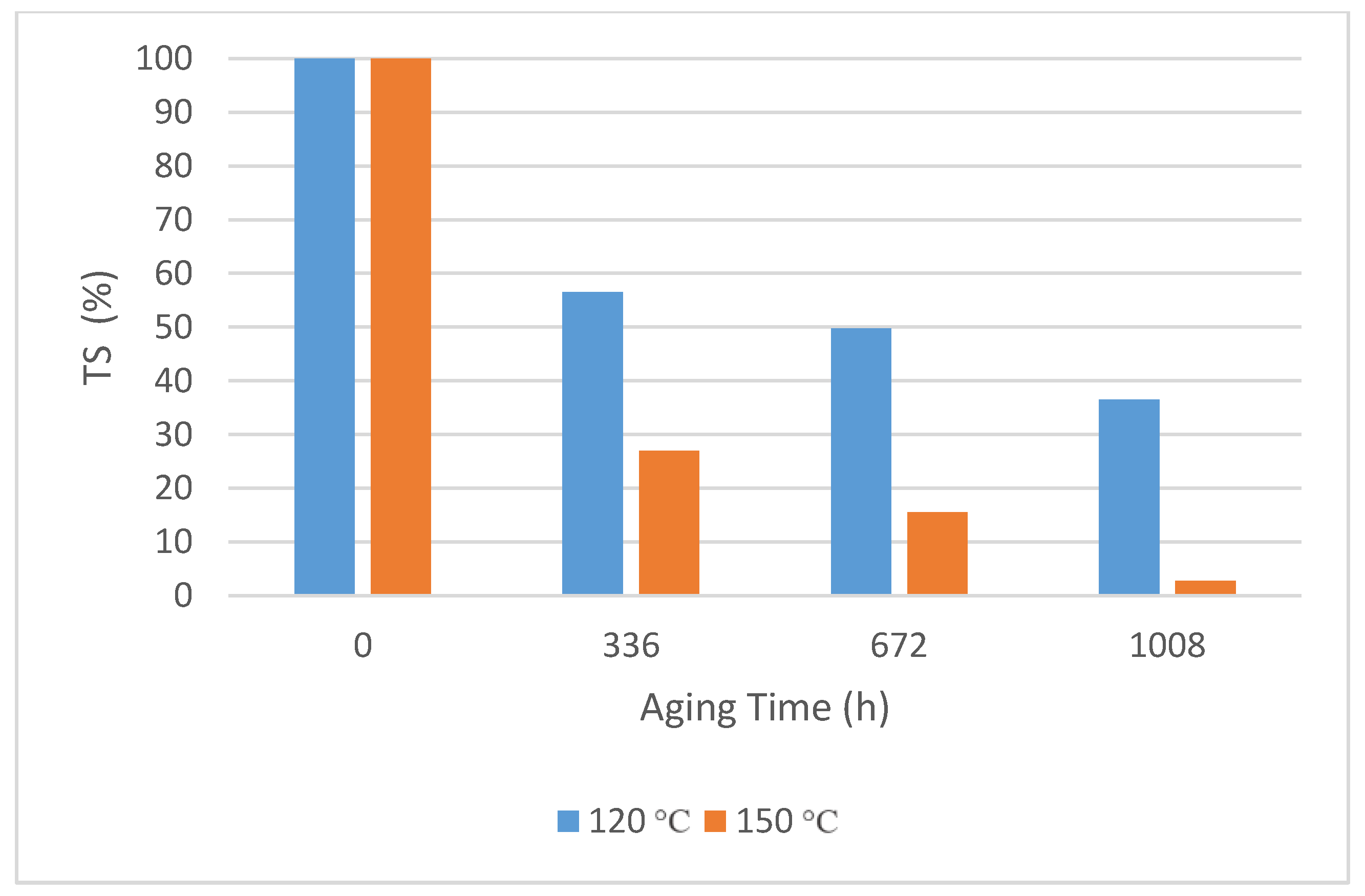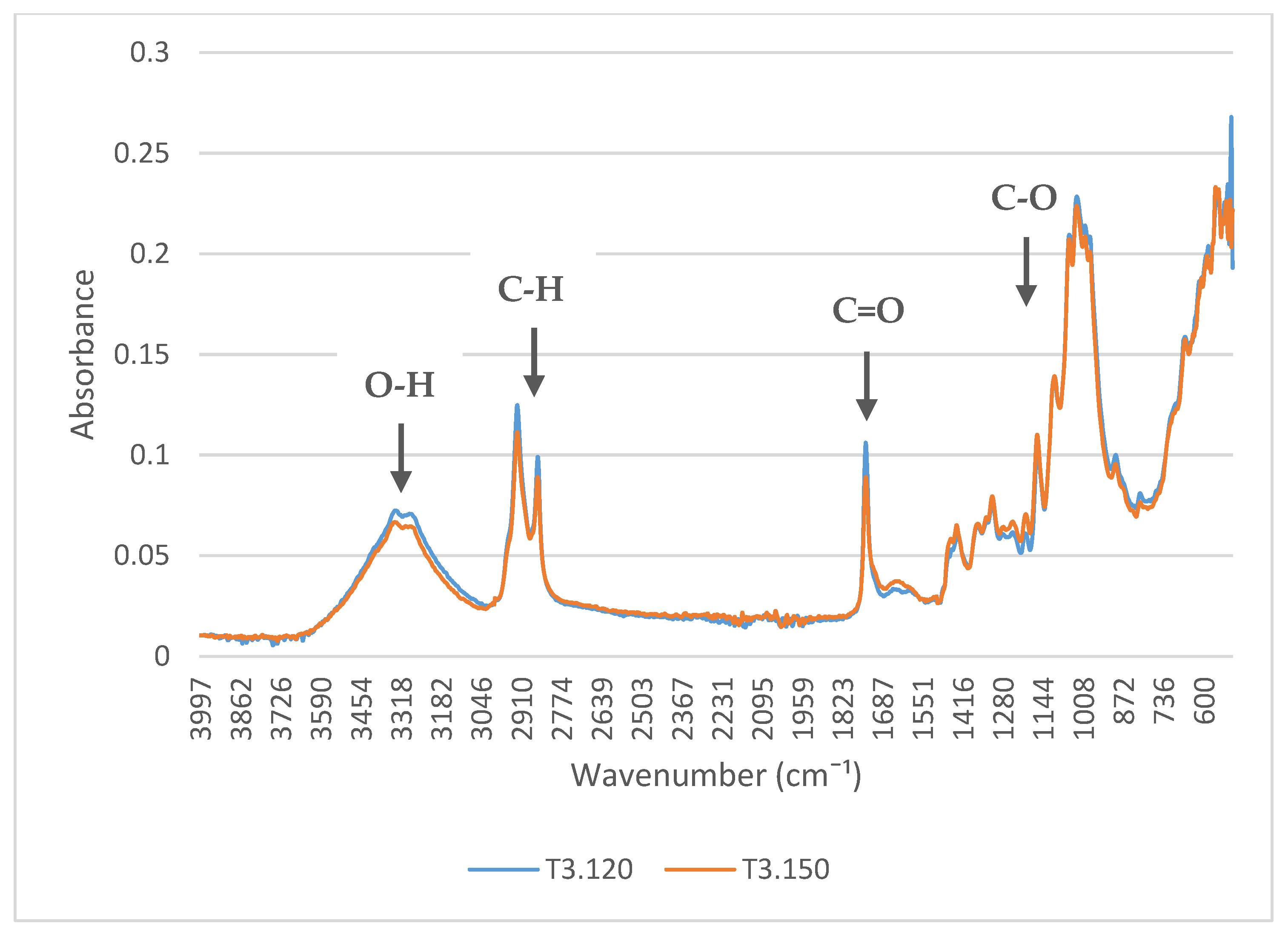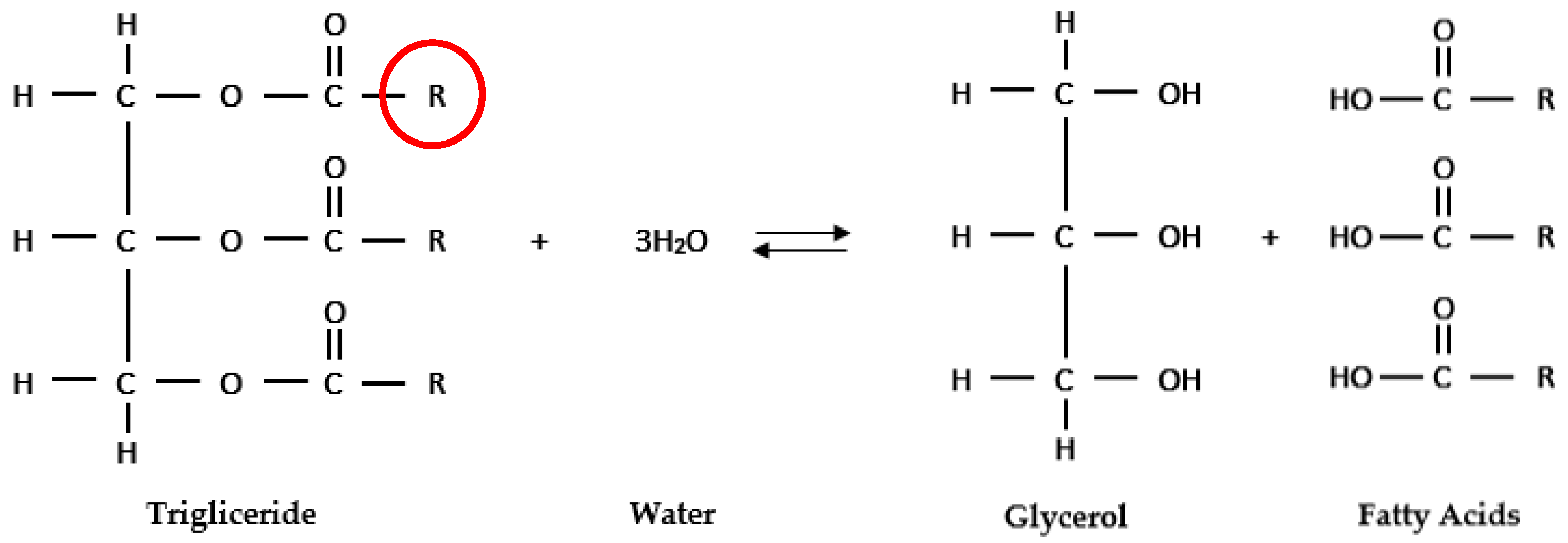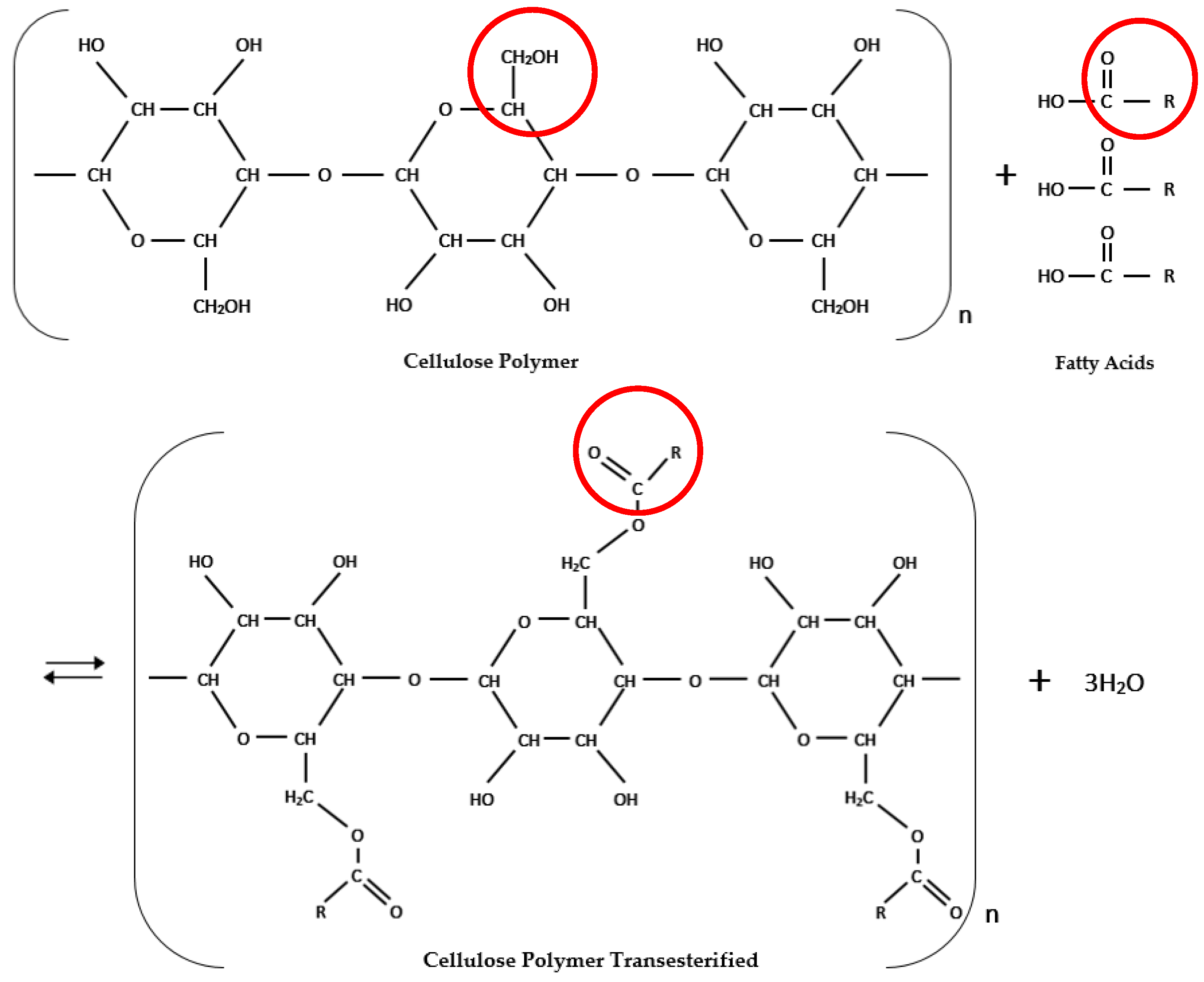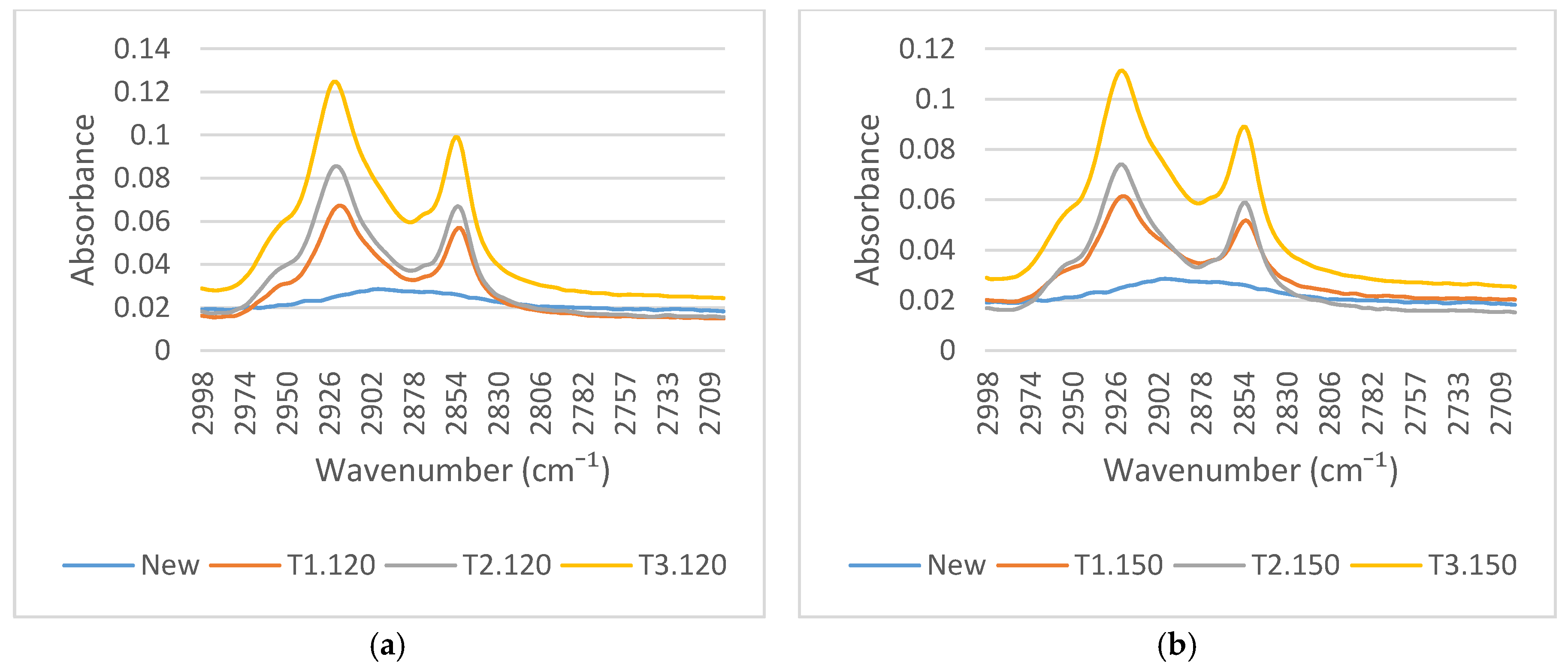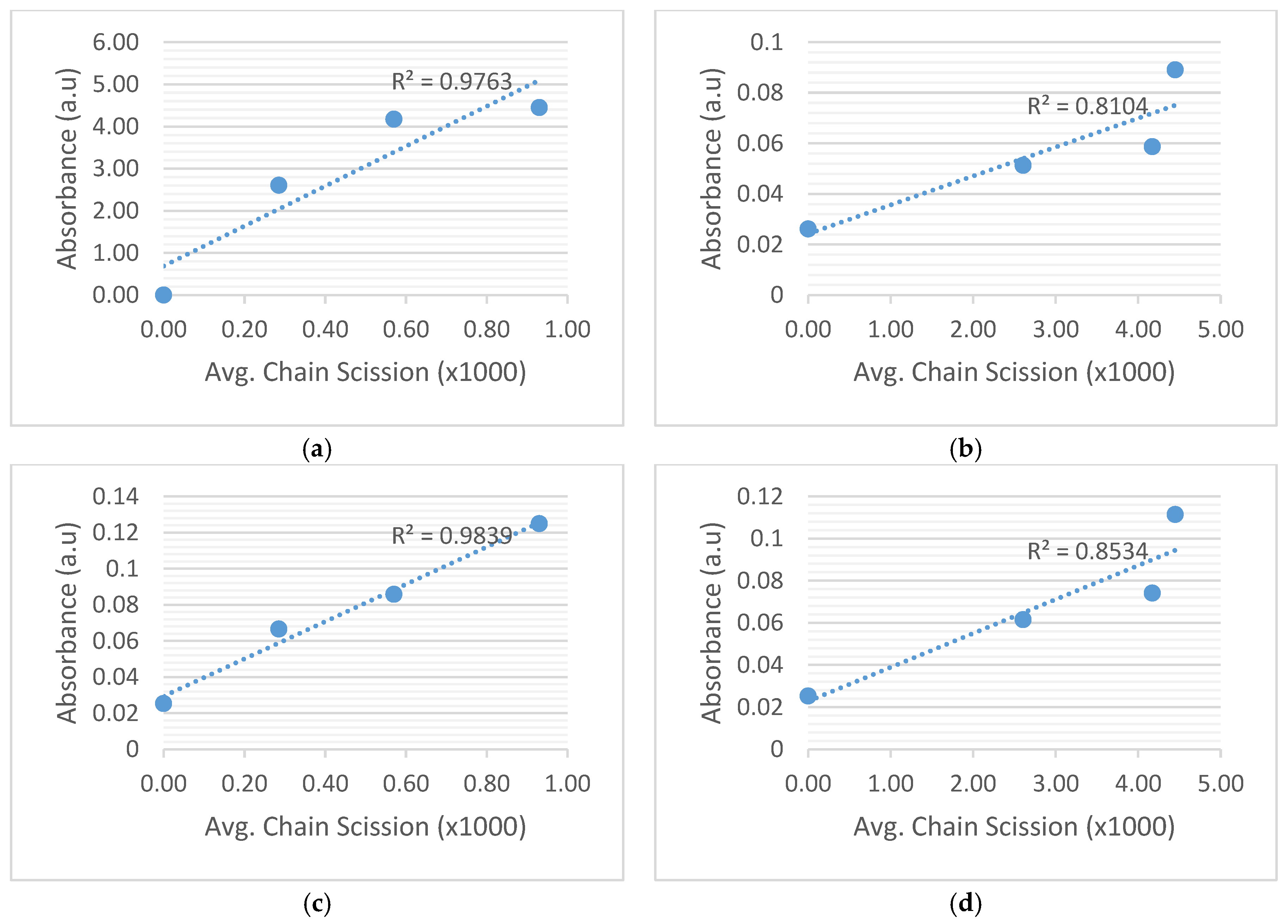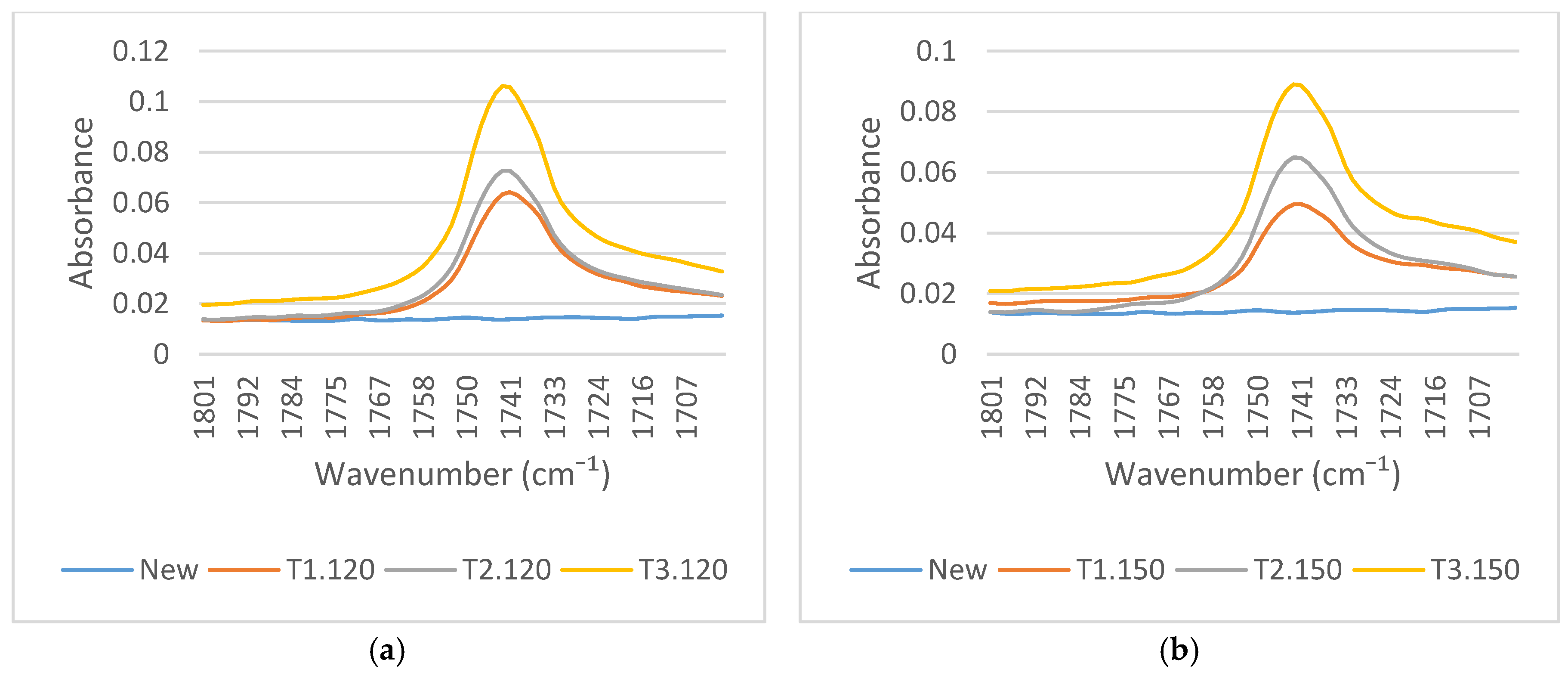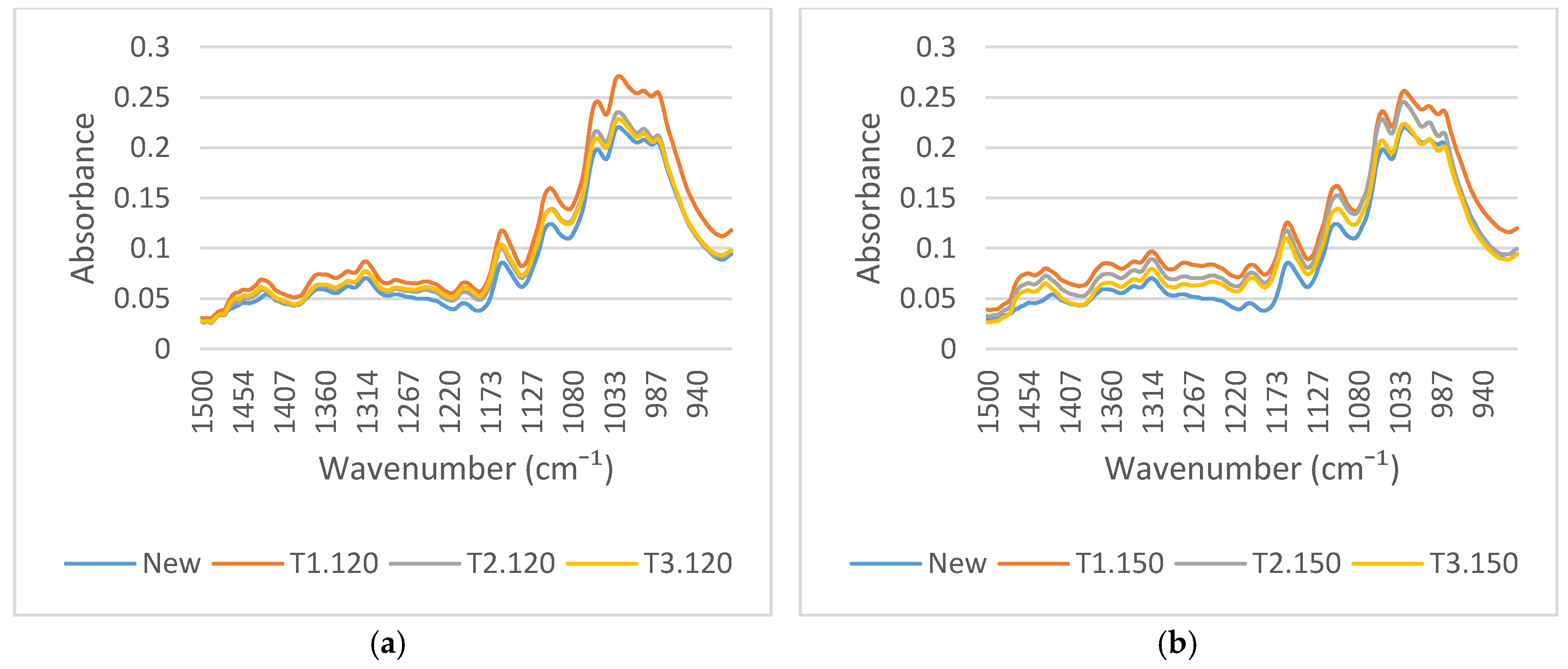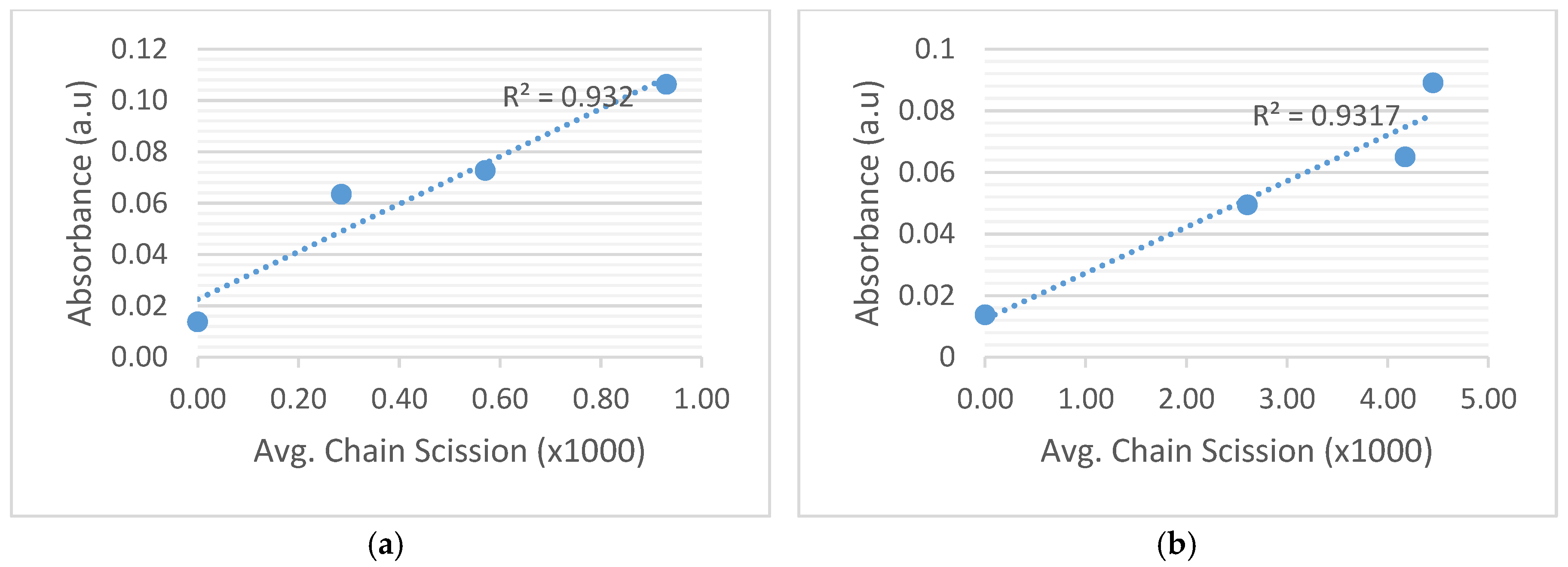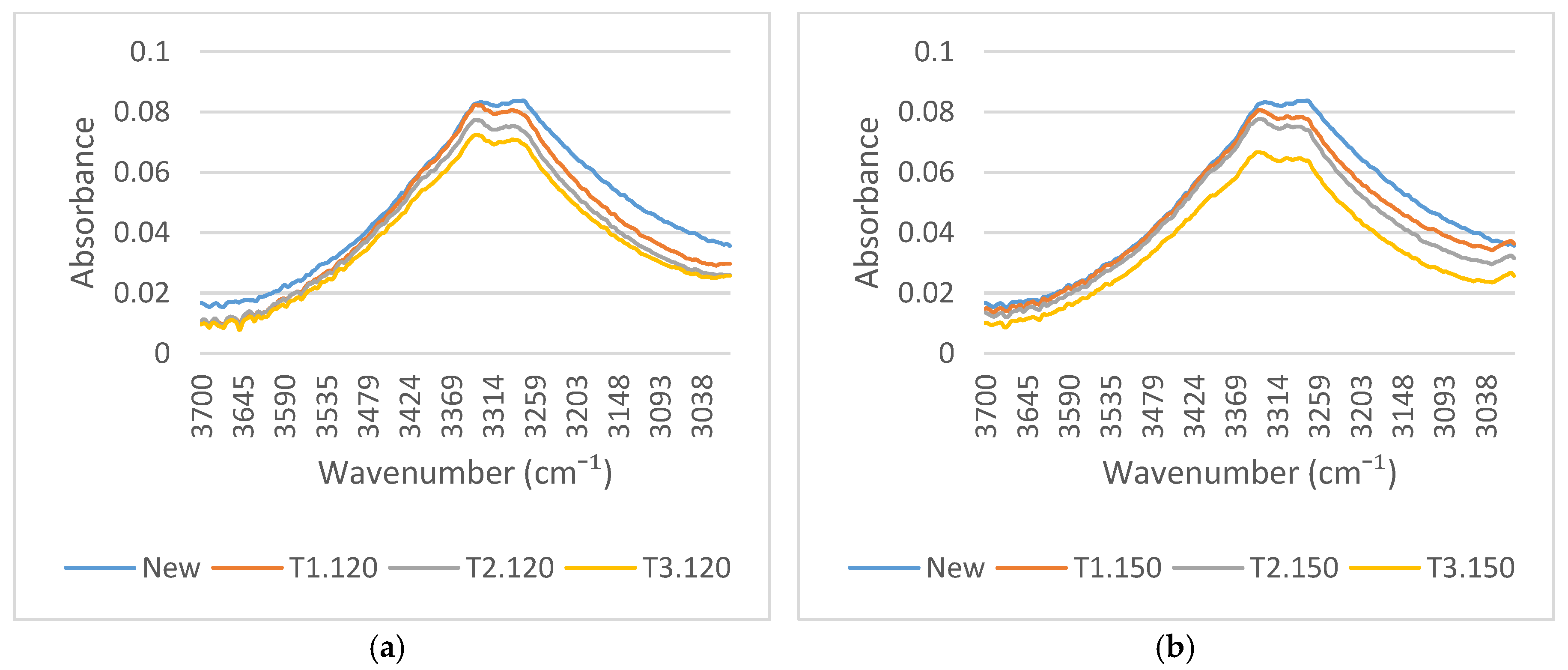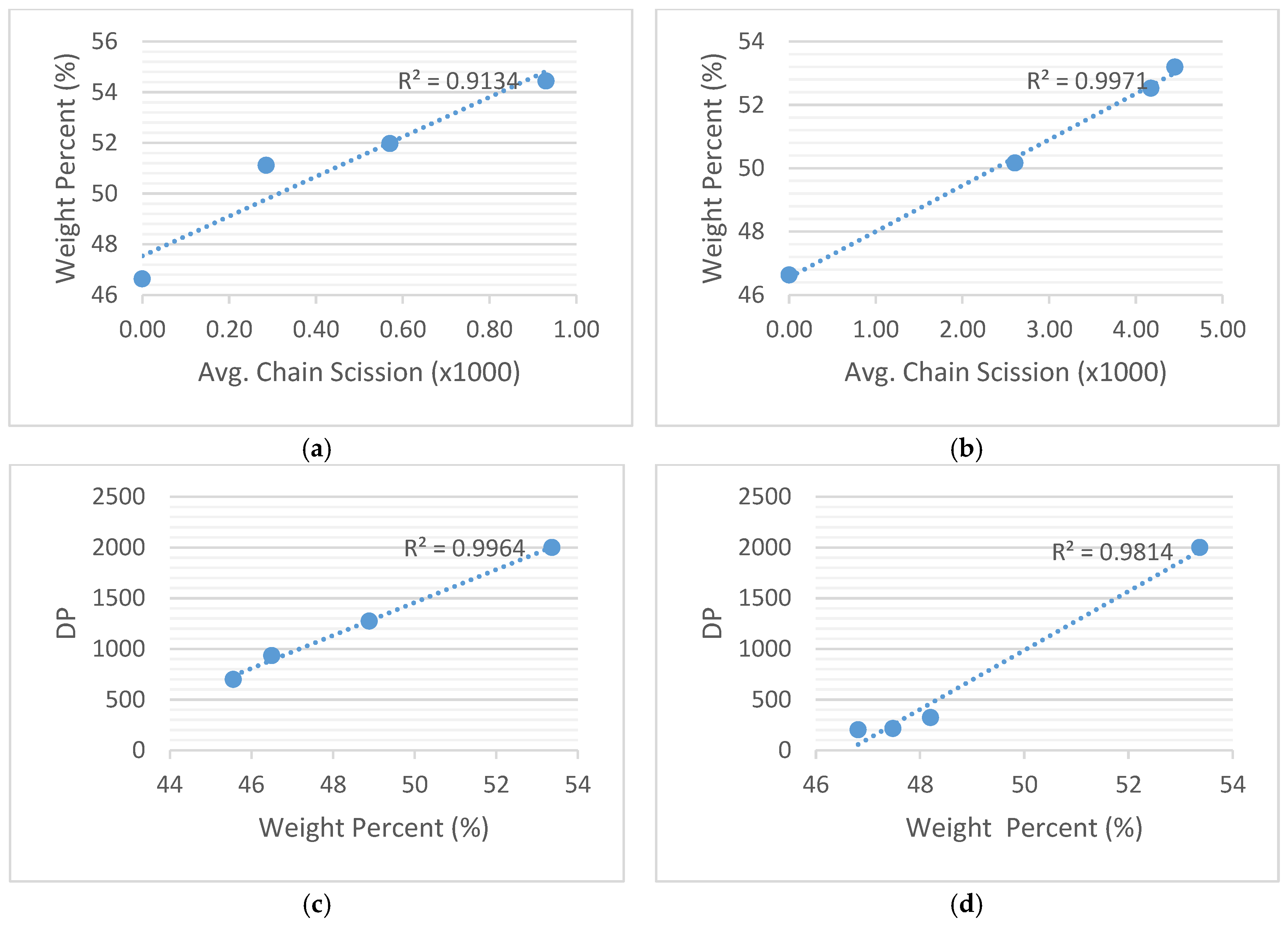3.1. Degree of Polymerization (DP) and Tensile Strength (TS)
Figure 2 shows the reduction of the DP of transformer insulation paper with aging at the temperatures of 120 °C and 150 °C. The DP indicates the number of C
6H
10O
5 glucose rings that compose the cellulosic macromolecule and it is the valuable indicator that provides information about the degradation state of cellulose and mechanical strength [
24]. It is seen that the DP has decreased faster at 150 °C than at 120 °C. At about 140 °C, the rate of the degradation process increases significantly, implying either a change in the activation energy or in the pre-exponential factor [
25]. The DP of paper samples aged at 150 °C was significantly decreased due to thermal stress at high temperature, in which the weak links existing in polymer chains are easily chopped [
3,
9,
26,
27].
Figure 3 shows the time dependence of TS under accelerated thermal aging at the temperatures of 120 °C and 150 °C. The figure indicates that the TS has reduced faster under higher temperature [
28]. From these figures it seems that the reduction behavior of the DP is similar to the TS.
Figure 3 shows TS values of insulation paper in natural ester at 120 °C and 150 °C within 0–1008 h. The transformer insulation paper under accelerated thermal aging at a temperature of 120 °C in natural ester reached the IEEE end-of-life criterion of TS 50% at 672 h. The transformer insulation paper under accelerated thermal aging at a temperature of 150 °C in natural ester reached the IEEE end-of-life criteria of TS 50% at 336 h, and TS 25% 672 h. The value of DP and TS have decreased due to thermal stress under accelerated thermal aging. The degradation process of transformer insulation paper due to thermal aging can be explained by the structural changes of the natural ester and the transformer insulation paper using FTIR and EDS. The interactions between the natural ester and transformer insulation paper during thermal aging involve hydrolysis and transesterification processes.
Figure 4a,b show the correlation between DP and TS of paper samples at the aging temperatures of 120 °C and 150 °C. In these studies, linear regression is used to get the correlation between DP and TS. R
2 is the correlation coefficient which has the value range of 0–1 or 0–100%. R
2 measures how close the data is to the regression line. The closer the value of R
2 is at 1 or 100%, the more positive a linear relationship the correlation has. The value of R
2 = 97.5% was for the correlation between DP and TS of paper samples at the aging temperature of 120 °C and the value of R
2 = 96.9% for the correlation between DP and TS of paper samples at the aging temperature of 150 °C, so there is a correlation between physical and chemical characteristics of paper samples which is shown by the correlation between DP and TS.
Table 2 shows the visual appearances of transformer insulation paper under accelerated thermal aging at different aging time and temperature. The color of transformer insulation paper become darker with aging [
29].
3.2. The Structural Changes of Transformer Insulation Paper
FTIR spectroscopy was used to analyze the structural changes which are shown by the intensity of peak absorbance of functional group of material.
Figure 5 shows the spectra of transformer insulation paper in natural ester under accelerated thermal aging for 1008 h at aging temperatures of 120 °C and 150 °C. The intensity of the peak absorbances of paper samples has a tendency to decrease with aging temperature due to the rate of degradation process which increases with aging temperature.
Table 3 and
Table 4 show the intensity of peak absorbance of the functional groups of the paper samples at the temperatures of 120 °C and 150 °C which will be analyzed in this research paper.
The predominant chemical reaction in natural esters subjected to high temperature is hydrolysis [
30]. Hydrolysis and transesterification process can change the chemical structure of transformer insulation paper which can be shown by FTIR analysis. Natural ester molecules are triglycerides, which consist of three fatty acids and one glycerol molecule [
9]. Triglyceride and three water molecules are involved in hydrolysis reaction [
10,
31].
Figure 6 shows the hydrolysis reaction of natural ester [
10]. This process generates glycerol and long chain of fatty acids and then the long chain fatty acids which have long-alkyl-chains (-R) consisting of a lot of C–H functional groups bind to the cellulose through transesterification generating transesterified cellulose and three molecules of water as shown in
Figure 7. The transesterification process involves cellulose and the long chain of fatty acids, which bind to cellulose.
Figure 8a,b illustrate the variations of FTIR spectra around 2900 cm
−1 of the transformer insulation paper at the aging temperatures of 120 °C and 150 °C. As shown in these figures, there are two absorbance spectra peaks at 2854 cm
−1 and 2922 cm
−1 which represent C–H functional groups.
Figure 8a,b show that the intensity of the peak absorbances of the C–H functional groups of transformer insulation paper have increased with aging due to hydrolysis of the natural ester and transesterification of the transformer insulation paper. as shown in
Figure 8 [
10]. So, the long alkyl chain which is initially part of fatty acids in natural ester binds to cellulose. Further, transesterification process in the insulating paper can be confirmed by C=O functional group at 1743 cm
−1 [
3].
Figure 9 shows the correlation between intensity of peak absorbance of C–H functional group absorbance (at wavenumber 2922 cm
−1 and 2854 cm
−1) and the average number of chain scissions of transformer insulation paper. In these studies, linear regression is used to get the correlation between the chemical structure and the aging performance characteristic of transformer insulation paper. Average number of chain scissions is used to describe the degradation of cellulose due to thermal aging, which is given in Equation (1) [
32]:
Figure 10a,b illustrate the variations of FTIR spectra around 1700 cm
−1. The C=O functional group didn’t appear in new transformer insulation paper, but there is a peak absorbance in its spectrum after thermal aging. This carbonyl band indicates the presence of an ester bonded to the cellulose, providing evidence that the transesterification has taken place [
30].
Figure 10a,b show the intensity of the absorbance peak of the C=O functional group has increased with aging, showing that the chemical structure of transformer insulation paper has changed after thermal aging. The C=O functional group which is initially part of fatty acids in natural ester binds to cellulose. The produced ester group firmly bonded water molecules to the ester group and the long chain fatty acids esterified on cellulose were arranged in parallel with the cellulose chain to form a “water barrier” that can reduce the potential damage of water on the transformer insulation paper [
8].
Transesterification of the long chain fatty acids may protect of cellulose insulation in two ways: by strengthening C–O and C–C bonds in cellulose and forming a barrier preventing water ingress to the cellulose [
8]. The intensity of peak absorbance of the C–O functional group at wavenumber 1159 cm
−1 of the aged transformer insulation paper is greater than in new transformer insulation paper as shown in
Figure 11. This peak confirms that transesterification process may allow the estimated lifetime of transformers that use natural ester as insulating liquid longer than when using mineral oil.
Figure 12 shows the correlation between the intensity of peak absorbance of C=O functional group at wavenumber 1743 cm
−1 and the average number of chain scission of transformer insulation paper.
Figure 13a,b illustrate the FTIR spectra variations around 3200 cm
−1. There are two absorbance peaks at 3273 cm
−1 and 3325 cm
−1 which represent the O–H functional groups. The intensity of the absorbance located close to 3340 cm
−1 can be attributed of hydroxyl groups which are a typical characteristic of cellulose [
33].
Figure 13a,b show that the intensity of the absorbance peaks of the O–H functional group decreased during aging. This O–H functional group decrease can be attributed to the reduction of molecular weight [
3]. The reduction of O–H functional groups is due to the hydrolysis reaction of cellulose, which generates glucose and oxidation reactions during aging which generate CO
2 and H
2O [
34].
Figure 14 shows the correlation between DP and the intensity of peak absorbance of the O–H functional group at wavenumber 3325 cm
−1 and 3273 cm
−1 of insulating paper.
The EDS results show that the main elements of transformer insulation paper are the elements C and O. The result is in accord with the fact that paper is composed of cellulose which has chemical formula C
6H
10O
5 [
35]. Hydrogen was not detected because the H 1s electrons are valence electrons and don’t participate in chemical bonding [
35]. Hydrogen are not useful in elemental identification using the EDS method [
36]. The result shows that the weight percent of the C element in transformer insulation paper has increased with aging as shown in
Figure 15.
Figure 16a,b show the correlation between the weight percent of C element and the average number of chain scissions of transformer insulation paper.
The result of EDS shows that the weight percent of O element has decreased with aging due to oxidation reaction of transformer insulation paper during aging which CO
2 and H
2O are generated from glucose.
Figure 16c,d show the correlation between DP and the weight percent of O element. From the
Table 5, the value of R
2 = 9134 and R
2 = 9971 indicate the correlations between average chain scission and the weight percent of the C element which are greater than the other correlation.
From
Table 6, the values of R
2 = 0.9964 and R
2 = 0.9814 are the correlations between DP and the weight percent of the O element which are greater than the other correlation. The value of R
2 of the correlation between DP and intensity of peak absorbance of the O–H functional group is very small because the degradation of transformer insulation paper increases significantly during thermal aging. This research shows that EDS can be used as a testing method to predict DP through the percentage of decreasing of O element.
